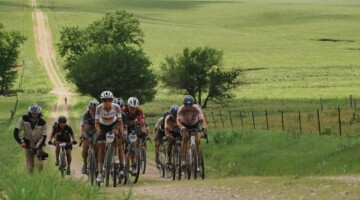
Our coverage of the 2018 Gravel Worlds is brought to you in part by Panaracer. Check out its line of gravel tires for your next adventure.
We have seen gravel racers who also excel on the road, at cyclocross and on the singletrack. But a gravel racer who is a fixed-gear crit star? That’s a bit new.
When Texas’ Colin Strickland is not grinding out long gravel miles, he can be found racing the Red Hook fixed-gear criterium series and their more traditional cousins. Why has he chosen to balance to the disciplines that are seemingly a gravel-race-distance apart from each other?
“In a word, fun,” Strickland said about his choice of racing disciplines.
“Both of these disciplines of racing are energizing people, growing in terms of popularity and exposure and drawing new people into the sport in ways that the European road racing model perpetually fails.”
Strickland started racing later than many top athletes, so his focus is primarily on putting on a good show and having a good time doing so. He can frequently be seen off the front at national-level crits here in the U.S. as he tries to spice up the racing.
Does that mean we can expect an ill-fated flier at mile 10 this weekend at Gravel Worlds? Not quite.
“The approach is very different in gravel races due to the lack of spectators and an audience,” Strickland said. “I try to race in a way that grows the sport, which in the case of gravel racing would be saying ‘hi’ to all the participants.”
Strickland will get a chance to say plenty of hellos this weekend when he seeks to defend his 2017 Gravel Worlds title. Strickland faces a tough challenge from Mat Stephens and others in his effort to take home the first-ever Gravel Worlds jersey with a new UCI-approved design.
We chatted with Strickland about his Gravel Worlds title defense coming up. We also asked about gravel and fixed-gear crit racing, growing the sport and the future of teams in gravel racing.
Interview with Colin Strickland, Defending Gravel Worlds Champion
CXM: How did you get into gravel racing?
CS: I have always preferred incorporating peaceful gravel routes into my training for road racing as a way of escaping the Austin auto traffic. I have raced cyclocross in Texas during the road off-season in Texas for many years, but my first “real” gravel race was The Castell Grind in spring 2017. I immediately loved the inclusive attitude and the fact that everyone who participated has a memorable and largely positive experience—as opposed to RR.
Not only do the handling and physical requirements suit me as an athlete, but I sensed right off that it was an area of cycling in America that would continue to grow rapidly, while most racing disciplines are struggling to expand participation.
CXM: These gravel fields seem to get more impressive every race. How are you feeling about your Gravel Worlds title defense?
CS: While I have done very well in crits and road racing already this year, I believe that these long endurance events are actually best suited to me. I am happy I won the race last year, and I would be even happier to win it again. I’m bringing a strong teammate and a strong guest rider, so I like our odds.
CXM: What is it about Gravel Worlds that makes it a race worth targeting?
CS: While the name is impressive on its own, it is always the quality of the competition that determines the significance and value of a race win. Additionally, I like that Gravel Worlds is a very fast-rolling course. In a sense, it is as close as you get to a road race course, while still having a gravel surface.
CXM: Do you scout out the fields before your gravel races? Do your competitors dictate how you race at all?
CS: I actually never scout out fields before races. I’m lucky if I looked at a course map, and really fortunate if I downloaded the course GPX file. While it can be effective to plan your race around the competition, I believe that takes a lot of fun out of the experience, so I just race my own race.
For example, last year at Gravel Worlds I had no idea that Tim Rugg was in the field. I definitely knew him as a dangerous pro road racer, but my teammate and I just went about our business cutting the race into a break that suited us, and we must have caught Tim napping because I never even saw him. So yeah, we will race whatever suits us and see how it goes.
CXM: The stories I’ve read about you racing crits seem to focus on attacking and putting on a good show. Do you use that same aggressive approach for gravel races?
CS: The approach is very different in gravel races due to the lack of spectators and an audience. I try to race in a way that grows the sport, which in the case of gravel racing would be saying “hi” to all the participants out on the road and after the race.
CXM: Fixed-gear crits seem to be a bit different than gravel racing. What has drawn you to the two disciplines?
CS: In a word, fun. Both of these disciplines of racing are energizing people, growing in terms of popularity and exposure and drawing new people into the sport in ways that the European road racing model perpetually fails.
CXM: Any chance fixed-gear gravel racing will become a thing?
CS: No. absolutely not. I think the MASH dudes have put on a couple of fixed gear cyclocross races in the Bay Area, but no.
CXM: How do you balance training for crits with training for long gravel miles?
CS: I’m really shitty at training in general. I prefer racing over training any day, so I much prefer “racing my way into shape.” I did a fair bit of long training rides pre-Dirty Kanza, but I wasn’t able to late-transfer into the race. That was not very awesome.
Since then, I’ve just raced a bunch of crits and done quite well off the fitness from those long rides. I started the sport late, so I just have fun, and it seems to work for me. No coach, no workout plans, just racing and training rides with high intensity. There is no balance, only fun.
CXM: What bike and tires will you be riding? How do you decide what tires to go with for gravel events?
CS: I will be riding the Pinarello GAN GR Disc, which I would argue is the ideal bike for the Gravel Worlds course. The bike is aerodynamic, with perfect clearance for 35 to 38mm tires. In a gravel race with high speeds and lots of exposure, this bike is ideal.
CXM With your own team [Meteor X Giordana], have you thought of building a bigger gravel squad for you and Amity Gregg?
CS: I enjoy racing much more than logistics and people management, so no, not really. I do have one teammate in Michael Sheehan, as well as a British guest rider named Dan Hughes, but I would never grow our men’s team beyond three riders. I prefer quality over quantity, and it has proven effective thus far. This also allows me to support the riders better. I have discussed the idea with Amity of adding one rider to the female roster, but the search continues.
CXM: Do you think teams in gravel racing are a good thing?
CS: I don’t think large teams are a good thing, but I do think that they are inevitable. I don’t think teams larger than three or four are a good thing in any U.S. racing disciplines besides the Euro-model UCI stage and one-day races. Outside of these types of events, it’s extremely rare to have more than one or two teams with equally large numbers, and the larger squads have a tendency to race negatively by intentionally slowing the race down, which is bad for bike racing as a whole.
Back to gravel racing: I think that numbers are power and as the level of support—think money—increases, so will the size of teams. Thankfully, I do think that gravel racing is less susceptible to negative racing than road racing.
CXM: In your Instagram post on the Belgian Waffle Ride, you said gravel races are the future of American racing. Why do you think that is?
CS: I think that gravel racing is the future of American racing because virtually everyone who goes to a gravel race has a memorable, and usually positive, experience. For most, it’s more a race against the course and yourself than the other racers, and that approach sets people up for a positive experience.
I have competed in many European-model bike races over the years, and that is not the future of racing in America. It really comes down to the experience. Gravel races and rides provide more of the participants with good experiences than does road or cyclocross racing. People who get dropped from a field or get pulled from a crit or ’cross race are less likely to come back for more punishment.
CXM: Do you think the Elite races at events like the Belgian Waffle Ride and Gravel Worlds should move toward big payouts as the caliber of the fields increase?
CS: I cannot speak to this. I try not to think about payouts because it takes the fun out of racing. In any given race, the odds of a racer, even a very good racer, winning the “Big Purse” are very, very low. I’ve known lots of “pro” racers who chase prize money, and they tend to not have very much fun.
I like to be surprised by winning a payout, and I usually am quite surprised. I don’t think that big payouts mean shit to good racers. I think the quality of the event creates the opportunity for a very marketable victory, and that’s what brings out talent, or at least the intelligent kind of talent.
CXM: Thanks. Looking forward to seeing you race this weekend.
CS: Thanks. It will be fun.



























